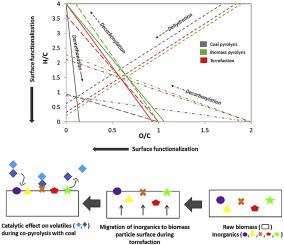Renewable and Sustainable Energy Reviews ( IF 16.3 ) Pub Date : 2020-08-17 , DOI: 10.1016/j.rser.2020.110189 S.M. Gouws , M. Carrier , J.R. Bunt , H.W.J.P. Neomagus

|
Thermochemical conversion via co-pyrolysis has the potential to be an efficient route for converting biomass to bio-energy and bio-refinery products. In this review, the implementation of co-pyrolysis of torrefied biomass and coal was critically assessed against co-pyrolysis of raw biomass and coal from both a fundamental and engineering perspective. This evaluation showed fundamental advantages for torrefaction of biomass prior to co-pyrolysis such as a decrease in mass and heat transfer limitations due to an increase in permeability and thermal conductivity of biomass. Co-pyrolysis volatiles may also be upgraded through the catalytic activity of the torrefied biomass surface, producing higher quality oil. Due to properties more similar to coal, torrefied biomass requires less energy for milling (lower operating costs) and can be more easily blended with coal in reactor feeding systems. A state-of-the-art research on co-pyrolysis kinetics revealed that reactivities of blends may be predicted from kinetic parameters of individual feedstocks using an additive approach. To conclude on the preferred reactor design for this process, different reactors were evaluated based on heat transfer mode, operation and product formation. Although both the fluidized bed and rotating cone reactor provide high oil yields, the rotating cone has been more successful commercially. This design shows great promise for specifically co-pyrolysis due to the intimate contact that may be achieved between fuels to maximize synergy. The co-pyrolysis of torrefied biomass and coal may be encouraged from a scientific point of view, however further research is recommended on the effective integration of torrefaction and co-pyrolysis technologies.
中文翻译:

煤和生/焙干生物质的共热解:化学,动力学和实施方法的综述
通过共热解进行热化学转化具有成为将生物质转化为生物能源和生物精炼产品的有效途径的潜力。在这篇综述中,从基础和工程的角度,严格评估了焙干生物质和煤共热解与原始生物质和煤共热解的性能。该评估显示了共热解之前生物质干馏的基本优点,例如由于生物质的渗透性和导热性的增加而导致质量和传热限制的降低。共热解挥发物也可以通过烘焙的生物质表面的催化活性而得到提质,从而生产出更高品质的油。由于特性与煤炭更相似,烘焙过的生物质磨粉所需的能源更少(运营成本更低),并且可以在反应堆进料系统中更轻松地与煤混合。有关共热解动力学的最新研究表明,可以使用加成法从单个原料的动力学参数预测共混物的反应性。为了总结出该方法的优选反应器设计,基于传热模式,操作和产物形成来评估不同的反应器。尽管流化床和旋转锥反应器均提供高的油产率,但是旋转锥在商业上已经更加成功。由于可以实现燃料之间的紧密接触以最大程度地发挥协同作用,因此这种设计显示出特定共热解的巨大前景。











































 京公网安备 11010802027423号
京公网安备 11010802027423号